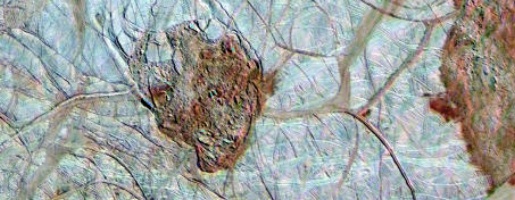 |
||
|
The dark, reddish regions of Thera and Thrace Macula,
evidence of a warmer interior.
|
||
| THE INTERIOR OF EUROPA | ||
| Europa is the fourth largest of Jupiter's moons and the smallest of the Galilean satellites. It has a density of 3300 kg m-3 indicating that like Io, Europa has a relatively large rocky mantle. It is quite likely that it also has a small iron and nickel core. | ||
| Analysis of the light reflected from the surface shows that Europa has an outer layer of water ice. The ice crust is thought to be about 10 to 30 kilometres thick. Below this may exist an ocean of liquid water, perhaps 70 to 100 kilometres deep. | ||
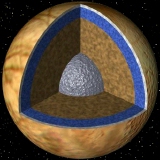 Europa's interior. |
||
| There is a strong similarity between the fragmented parts of Europa's surface and pack ice which forms in the polar seas on Earth. This is a very good indication that fluid existed just below the surface at some point in Europa's history. | ||
 Ice rafts on Europa's surface |
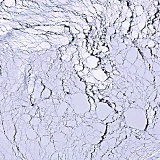 Thick pack ice with a few leads of open water. Wedell Sea, Southern Ocean (70 degrees South). |
|
| Parts of Europa's surface have been fractured and rotated. The rotation may imply that the fragments are being churned by convection processes operating in a lower, liquid layer. Again, similar processes cause rotation of Earth's icebergs. | ||
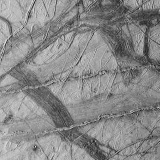 Wedges on Europa show similarities to terrestrial tectonics. |
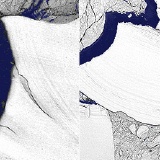 The fracturing of large icebergs at the edge of the Filchner Iceshelf between 1973 (left) and 1986 (right). |
|
| Additional evidence for an ocean layer beneath Europa's crust can be found in the triple bands. The triple bands appear to have been formed when the surface split apart and allowed an upwelling of fresh clean water, the water forming the bright central part of the band. | ||
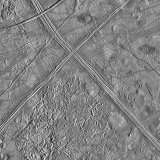 Wide-angle view of the Agenor Linea triple band. |
||
| If there is a deep, hidden ocean on Europa, why isn't it frozen? At Europa's great distance, solar heating is minimal, and can only generate temperatures in the region of about 100 K (about -170o ), clearly below the freezing point of water. Furthermore, solar heating can't explain a frozen surface and a melted interior. The answer may lie in Europa's orbital eccentricity. The eccentricity of Europa's orbit causes the moon to be subjected to gravitational stresses that distort its shape. The constant and regular distortion generates heat within Europa, and can explain the cracked surface. Such tidal forces are also capable of warming Europa's deeper ice and forming an ocean. | ||
| Europa's suspected ocean has yet to be positively identified, and future missions may be needed to confirm one exists; however, results from the Galileo orbiter's magnetometer instrument are consistent with the presence of a liquid layer below the crust, and scientists are almost certain there is one. The interest in Europa's ocean stems from the possibility that a deep, warm ocean of water can harbour early life - after all, this is how life started elsewhere in the Solar System. | ||
|
|
||